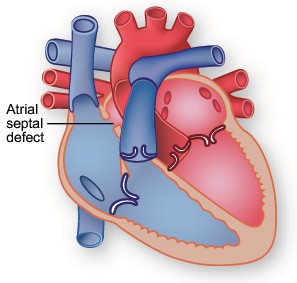A septal defect is a hole in the septum, the muscle wall separating the chambers of the heart. A septal defect is sometimes called "a hole in the heart."
 If a baby is born with a hole in the septum, blood leaks back from the left side of the heart into the right. If the leaking is minor, there may be only minor problems. But if there is a lot of leaking, the heart will try to make up for this by getting larger. Children who have a septal defect usually have trouble breathing and do not grow normally.
If a baby is born with a hole in the septum, blood leaks back from the left side of the heart into the right. If the leaking is minor, there may be only minor problems. But if there is a lot of leaking, the heart will try to make up for this by getting larger. Children who have a septal defect usually have trouble breathing and do not grow normally.
What is an atrial septal defect?
Atrial septal defect (ASD) means that the hole is located between the upper chambers of the heart (the right and left atria). Since the pressure is higher on the left side of the heart, blood gets pushed through the hole from left to right. This may cause the right atrium to become enlarged.
Before birth, the fetal heart has an opening (called the foramen ovale) between the left and right atria. Usually, this hole closes soon after birth. If it does not close completely, the problem is called an ostium secundum defect. Ostium secundum defect is the most common kind of ASD. Other kinds include ostium primum defect and sinus venosum defect. Each type of ASD is associated with a hole in a different part of the atrial septum.
What are the symptoms and signs?
Symptoms and signs of ASD include
- Shortness of breath or trouble breathing
- Palpitations (feeling your heart beat strongly)
- Failure to grow normally
Even though ASD is present from birth, symptoms often do not appear during childhood. Instead, the right atrium may become larger over time, causing problems in adulthood. Adults with ASD may experience arrhythmia or heart failure.
How is it treated?
About 40% of atrial septal defects will close by themselves before the child is 2 years old. After that time, natural closure is rare, so surgery is usually recommended in serious cases (when the right side of the heart is enlarged).
Surgery involves covering the hole with a patch. To close the hole without open-heart surgery, some doctors may use a catheterization procedure to insert tiny devices called occlusion devices which are used to block the hole.
Surgery to close an atrial septal defect is successful in 99% of cases. If the surgery is done in childhood, the enlarged heart will return to its normal size in 4 to 6 months.
Return to main topic: Congenital Heart Disease
See on other sites:
MedlinePlus
https://medlineplus.gov/ency/article/000157.htm
Atrial septal defect
Texas Adult Congenital Heart Center (TACH)
www.bcm.edu/healthcare/care-centers/congenital-heart
This Baylor College of Medicine program enables patients with congenital heart disease to receive a seamless continuation of care from birth to old age.
Updated August 2016



